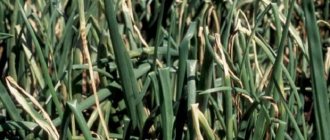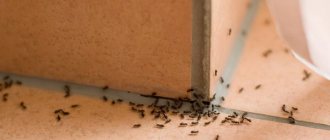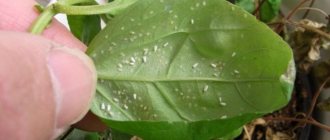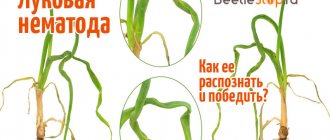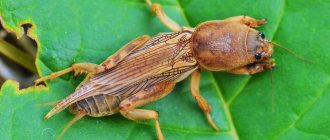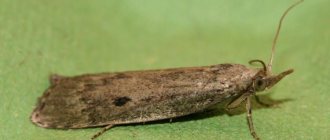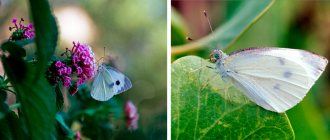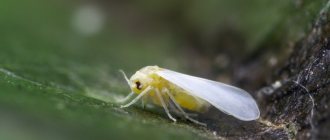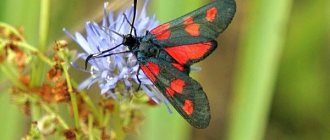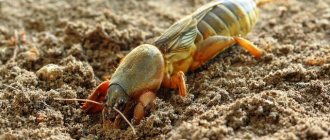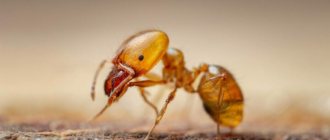Externally, the onion moth - the photos confirm this - looks completely inconspicuous. This is a butterfly with a dark brown body, the hind wings of which are light gray in color and long fringe, and the front wings are brown with several transverse white stripes and a large white spot at the lower edge of the wing. The body length of this insect pest is 8 mm, and the wingspan is 10...17 mm.
Moths on onion plantings begin to fly in May, and they are more active at night. At this time, butterflies try to lay a single egg on the following parts of the crop:
- on the necks of the bulbs;
- on the lower parts of the bow arrows;
- on flower arrows.
The fertility of each female ranges from 50-75 eggs. The eggs are 0.4 mm long and up to 0.3 mm wide, yellowish, oval in shape, convex on the upper side.
A week after the moth lays eggs on the bulbs, larvae appear. After another 7 days, small (10...11 mm) caterpillars appear from these larvae, yellow-green in color, with brown warts, from which short hairs grow. On the plant, they bite into the leaf pulp, and, making narrow passages, penetrate into the cavity of the shoots or onto the inside of the leaf blades. By damaging the tissues of the leaf plate and peduncles, gnawing the peduncles, the insect leads to the loss of onion seeds.
After one and a half to two weeks, the caterpillars of the moth that settled on the onion plantings crawl out through the leaf blades, move to nearby weeds and equip their cocoons for the next stage of their development. The cocoon, with the pupated caterpillar, has a loose, grayish-web-like structure. The dark brown pupa with a white tip reaches 7 mm in length.
Since the pupal stage lasts only 9-13 days, after which the next generation of pest butterflies fly out of the cocoons, control of onion moths must be carried out with enviable frequency. This usually happens in July and August. In southern regions or during particularly warm summers, three generations of these insects can develop. Butterflies that emerge from their pupae remain for the winter, and in May they will begin their flight.
Appearance Features
These insects from the order Lepidoptera parasitize vegetable crops. Small brown butterflies, decorated with white spots and cross-striations, are found in every vegetable garden. Adults have a pale triangle near the posterior border of the forewings. The bodies of butterflies have an elongated shape, the head and back are brown.
The hind wings of the onion moth are narrow. Their gray or cream color is familiar to most farmers. In the photo of the moth, the long hairs framing the free edge of the hind wings are clearly visible.
Photo of onion moth
Preventive methods
Basic rules for storing food in an apartment:
- All dry cereals must be checked for expiration date upon purchase. The best option is to move them into airtight containers while checking them for insects.
- In kitchen cabinets and drawers, paper “stickers” against moths with an outer sticky layer are placed on the walls. These signal strips will not only scare away insects, but will also immediately indicate the moment of their appearance. It will be enough to simply check the appearance of such indicators.
- Additionally, you can place homemade sachets with herbs or cedar moth balls. Strong odors will keep butterflies away from groceries.
Regular cleaning of furniture and ventilation of cabinets in the house is necessary to prevent the larvae from remaining at a comfortable room temperature.
Also, you should not keep dirty things in your wardrobe, because the remains of sweat are attractive to insects.
Carry out preventive measures
Not really
You should be especially careful when it comes to storing clothes for winter or summer outside the season. It is best to use vacuum sealed bags. If clothes are packed in fabric covers or trunks, then each protective bag should be equipped with a lavender sachet, since this plant best retains a stable scent for several months.
Furniture or carpets can be treated with insect repellent sprays, but this method is dangerous for allergy sufferers. Cedar balls or herbs will be an alternative solution.
If the threshold for an allergic reaction is too high, then a steam generator is needed in the house. This is the best pest repellent without any side effects.
Previous MothWhat moths don't like
Life cycle
Onion moths are sexually dimorphic. Mating of adults occurs from April to September. If the autumn is warm, the process can last until October. In cool climate zones, pests become active later, most often in June or July.
Females lay oval eggs on the back of leaves, necks of bulbs, and inflorescences. These are embryos from which larvae (green caterpillars) later emerge.
Insect development occurs in stages:
- The appearance of a microscopic egg.
- Formation of the caterpillar.
- Insect pupation.
- A moth emerging from a cocoon.
Attention! In order for the fight against onion moths to be as successful as possible, it is necessary not only to repel the butterflies, but also to destroy the female pests before they begin to lay eggs.
Main Factors
If the onion bed has been properly cared for: watering, fertilizing, loosening, weeding, then all that remains is to look for the reasons for the yellowing of the feather tips in serious problems:
- infectious diseases;
- insect pest activity;
- exposure to changing weather conditions;
- unsuitable soil composition.
Yellowing of the stems in late July or August should not cause alarm. By this time, the bulbs are ripening, and the natural drying of the greenery begins. But the change in feather color in June should be alarming.
To understand the reason for the drying out of the tips of the leaves, you need to dig up a couple of heads and carefully examine them.
Insect larvae and eggs
The transformation from an embryo into an adult butterfly (imago) lasts for onion moths up to 40 days. The female lays more than 90 eggs at a time. They are white or cream in color, length from 0.2 to 0.6 mm. The duration of insect development at this stage is up to 10 days.
The larvae are yellowish-green caterpillars with brown warts and hairs. They damage leaves by gnawing out areas on the inside, destroying buds, and eating stalks. The activity of moth larvae leads to the death of crops. The duration of insect development at this stage is two weeks.
Moth pupae are spindle-shaped and located on the back of the leaf. They develop in about 15 days. Transformations of a growing insect occur not only on the shoots of vegetable plantings, but also on crops growing near the beds.
For your information! To get rid of onion moths at the very beginning of the insect’s development, it is best to use products made from natural ingredients.
Folk remedies
Among such means are the following: aromatic oils and plants with strong odors.
Moth repellent No. 1 – Aromatic oils
You need to purchase aromatic oils and cotton pads.
The following scents are suitable:
- rosemary;
- basil;
- geranium;
- carnation.
Aromatic oils - a budget-friendly and effective remedy for moths
Aromatic oils should be dropped onto cotton pads and spread in places where the insect lives or may appear. In addition to the above, camphor oil is effective. Food moths will not be able to coexist with such a smell.
Remedy No. 2 – Garlic
To get rid of moths in cereals, you need to put cloves of garlic in a container with them. The pungent smell will repel food moths. The presence of garlic will not affect the taste properties of the products.
Remedy No. 3 – Lavender and citrus fruits
Butterflies cannot stand the smell of these plants. Therefore, you need to collect peels from oranges, lemons or grapefruits and put them in cabinets. Lavender oil will also help. It must be applied to a cotton pad and left on a shelf in a cabinet with insects. An alternative to oil is fresh flowers wrapped in gauze or bandage. Such a small bouquet can be easily placed in any place where the pest lives.
The aroma of lavender will repel moths for a long time
Remedy No. 4 – Bay leaf
This seasoning has a specific smell that the food butterfly does not like. Lavrushka is laid out in containers with cereals and among products in the cupboard.
Remedy No. 5 – Vinegar
All cabinets must be cleared of foreign objects and food. Joints and cracks must be treated with soapy water. You can use an old toothbrush for these purposes. Then the cabinet is washed clean and ventilated. The final step is to wipe the surface with a vinegar solution. This is a very effective and well-proven remedy for food moths.
Remedy No. 7 – Tobacco
Proper storage of food in the kitchen - and you will not need to be afraid of moths
You can remove moths from the kitchen in this unusual way. Placed tobacco on cabinet shelves repels food pests.
Remedy No. 8 – Walnut leaves
The plant, or rather its leaves, have a special smell. If you lay out a few fresh nut leaves, this will repel moths.
WATCH THE VIDEO
Now you know how to get rid of moths in the kitchen.
What harm does onion moth cause?
The period of maximum activity of butterflies occurs at night and on cloudy days. It is in the dark that female moths lay eggs. Inexperienced gardeners rarely pay attention to moths fluttering over the beds at dusk. Meanwhile, before the eyes of the farmer, pests choose a place to reproduce. It must be remembered that the onion moth is a serious enemy, which is best neutralized before the voracious caterpillars appear.
Insect larvae do the most damage to plantings. They feed on the pulp of plants, climbing inside the feathers. The leaves turn yellow and begin to dry out at the tips. Sometimes the caterpillars penetrate the bulbs, completely destroying the plant.
Attention! The presence of moth larvae hiding inside the feathers of plants is determined by light stripes on the leaves.
Is this parasite dangerous for humans?
Unlike other various parasitic insects, moths do not cause much harm to a person and his apartment if it is removed from the house in time. This moth often destroys only certain clothes.
Certain types of moths (for example, the cereal moth) damage food products such as cereals, chocolate and nuts. However, this type of moth does not cause significant harm to humans.
Why are moths dangerous?
It harms a person in the following ways:
- spoils the appearance of food;
- contaminates dishes;
- destroys clothes;
- causes discomfort.
Such a lepidopteran parasite is dangerous to human health only if he does not get rid of it in a timely manner.
Pest control measures
If onion moths appear in the garden, the first thing the farmer should do is determine whether there are many pests grazing on the crops at that moment. With a small number of parasites, you can do without the use of chemicals. Folk remedies will help get rid of larvae and butterflies. Such compositions are always preferable, because they are safe for the site’s ecosystem and human health.
If there is a significant spread of parasites, experts recommend using insecticides. A prerequisite for the use of chemicals is compliance with the optimal dosages of the drugs indicated on the packaging.
Attention! Chemicals should not be used in the garden 3-4 weeks before harvesting vegetables from the beds. Chemical compounds harmful to human health remain on crops for 30 days.
Chemical methods
If 1/10 of the plantings are occupied by caterpillars, the farmer cannot do without insecticides. Competent farmers spray immediately after the larvae hatch from the eggs.
| Product name | How to use |
| "Summer resident" | Dissolve 1 ml. product in a liter of water, add liquid soap (20 g), mix. Spray the beds. |
| "Spark" | Dissolve a tablet of the product in a glass of water, pour the mixture into a bucket of water. The product is moderately dangerous; it should be sprayed wearing protective clothing and a respirator. The insecticide cannot be combined with the use of drugs that have an alkaline reaction. |
| "Metaphos" | Sold as an emulsion. The working mixture is prepared according to the instructions. Duration of protection – 3 weeks. |
| "Karate Zeon" | The liquid preparation is diluted in the following ratio: 1 ml per bucket of water. facilities. Spraying is carried out twice, maintaining an interval between the first and second treatments (14 days). |
For your information! Chemical means of combating onion moths give the best results if implemented on calm days. Avoid dripping of the solution onto the ground.
Folk remedies
The effectiveness of natural solutions is significantly lower than chemical ones, but they are safe for people and animals. Most of these products work through repellent scents. Experienced gardeners repeat treatments with folk remedies every week. Such measures in pest control always pay off.
Infusions are prepared based on:
- wood ash;
- fragrant herbs;
- pepper (hot);
- tobacco concentrate.
Scented herbs
Many farmers plant wormwood, calendula, and yarrow next to their vegetable beds. Onion moths cannot tolerate the strong smells of herbs. Decoctions for spraying are prepared based on lemon balm, mint, basil, valerian, tansy, and dandelion. Crushed herbs (200 g) are poured with hot water (10 l.), Infused for 5-6 days. The beds are processed in the evening.
Most gardeners know that onions and garlic are friends with carrots. If these crops are planted nearby, they will repel harmful insects from each other with their smells.
Wood ash
Sometimes tobacco dust is used simultaneously with wood ash as a pest repellent powder. The components are mixed (1:1) and scattered over the garden bed once a week. This remedy works well against adult insects, but is powerless against larvae. Therefore, it is important to get rid of adults in time before they reproduce.
Salt
One of the most reliable and practical remedies for onion moths has long been table salt. It is used dry or a special solution is made. In the first case, young shoots of garlic and onions are sprinkled with salt, and then it is embedded in the soil, loosening the row spacing. Some gardeners enhance this effect with wood ash.
If a farmer chooses to use a saline solution, he should know that “therapeutic watering” must be done 3 times during the season. The work flow is as follows:
- dissolve coarse salt (300 g) in a bucket of water, water the crops at the germination stage;
- make a concentrated solution (600 g of salt per bucket of water), water the crops 2 weeks after the first treatment;
- prepare a saturated salt solution (1 kg per 10 liters of water), water the onion and garlic beds 21 days after the second treatment.
After a few hours, you should rinse the plants from salt residues from the watering can. Additional abundant watering will not be superfluous.
Sweet traps
Some gardeners make sweet traps for parasites. They are constructed from containers filled with sugar water, honey solution, and compote. Moths, seduced by the scent of the bait, drown in it.
Who are these annoying dipterans?
Biological description
A fly is a flying insect with a body length from 2 mm to 2 cm. The body of a fly consists of 3 parts: head, thorax and abdomen.
The insect flies with the help of a pair of membranous wings, and moves along the surface (horizontal, vertical and ceiling) with 3 pairs of legs. This is possible due to the fact that each leg consists of 5 segments, the lower of which (the foot) has 2 claws and a sticky pad.
On the head of the fly there is a proboscis, through which the insect sucks in liquid food, two short olfactory antennae and two large eyes with several thousand hexagonal facets. She has all-round vision, she sees everything that happens not only from the front and sides, but also from behind, and with her antennae she recognizes odors at a great distance.
White, black and miners
There are now such a huge number of varieties of flies (more than 40,000 species) that scientists find it difficult to classify them
But for an ordinary person, it doesn’t matter what species or class a given insect belongs to, but what matters is what it eats and how dangerous it is. Therefore, dipterans are divided into:
- aphagi - adults, do not feed on anything;
- hematophagous - prefer to feed on blood;
- coprophages - in natural conditions they accelerate the process of decay of excrement;
- necrophages - eat dead organic matter;
- nectarophages - the name speaks for itself - plant nectar is eaten;
- polyphagous - they eat everything.
The gardener has his own priorities - he must know which flies are harmful to vegetables and which are beneficial:
- The enemies of cabbage are 2 types of flies - spring cabbage fly and summer cabbage fly.
- There are also miners - small insects that lay eggs under the skin of leaves, inside which the larvae then gnaw out passages. However, this variety is polyphagous, appears in late spring - early summer, and prefers cucumbers, salads and tomatoes, so it does not pose a particular danger to cabbage.
- There is also a useful fly - the hoverfly, which feeds on aphids and sometimes small caterpillars.
Habitat
Vegetable pests specialize in certain vegetables. Cabbage flies often live, reproduce and overwinter in cabbage beds; True, they do not disdain other cruciferous vegetables. These insects can also lay eggs on wild and weedy cruciferous plants.
Appearance
In appearance, cabbage flies are very similar to house flies.
And spring and summer differ in color and size:
- Spring males are dark gray in color with black stripes on the back and reach a size of 5-5.5 mm. Females are light gray in color, slightly larger - 6-6.5 mm. The wings of this variety are transparent with dark gray streaks.
- Individuals of the summer variety reach a length of 7 to 8 mm and have a yellow-gray body and transparent, yellowish wings with yellow veins.
How does it reproduce?
- The flight of spring dipterans begins at the end of April, and after 2-3 days they mate. After 1-2 weeks, the female lays 100-150 white cigar-shaped eggs measuring 1-1.2 mm on the root collar of the seedling or in the soil next to the cabbage. The full cycle from egg to adult insect takes 40-60 days, and depending on the region, regenerations can range from 1 to 3.
- Summer (large) cabbage flies mate 7-10 days after emergence. The female also lays from 100 to 150 eggs, but only one generation develops per year. From the eggs, after 5-10 days, depending on the humidity and temperature of the soil, white legless larvae 8 mm long appear.
Danger to cruciferous vegetables
Cabbage flies (spring and summer) are equally harmful to all subspecies and varieties of cabbage, as well as to:
- rutabaga;
- radish;
- radishes;
- turnips
This is due to the fact that it is not the flies themselves that attack the crops, but their larvae, which eat the roots and root crops of the plants. Therefore, it is not so easy to detect them.
At what time of year do plants usually suffer?
Important!
Early cabbage varieties are attacked by the first generation of spring cabbage fly larvae in early May. The second generation, depending on weather conditions, can attack as early as late June - early July.
Summer cabbage fly larvae attack mid-season and late-season cabbage varieties:
- in the southern regions - in mid-June;
- in the middle zone - at the end of June;
- in the northern regions of Russia - in mid-July.
Prevention of occurrence
If a farmer properly cares for onion and garlic beds, the likelihood of onion moths being present in the garden is significantly reduced. To create conditions unfavorable for pests you need:
- conduct crop rotation correctly;
- weed the plantings in a timely manner;
- regularly loosen the soil;
- thin out plantings and remove diseased plants;
- plant mustard and wormwood next to the beds.
To destroy moth pupae hidden in fallen leaves, it is necessary to thoroughly clean the beds of plant debris in the fall. Adding organic matter to the soil will also reduce the number of pupated pests.
Attention! If in the spring (before planting) you wash the bulbs in a solution of potassium permanganate, the likelihood of pests appearing on the site will decrease several times.
Any farmer can protect his garden from onion moths if he is not too lazy to regularly inspect the crops and will be able to take timely measures when pests appear. To grow an environmentally friendly crop, you should first use natural means of combating parasites.
If the pest larvae have managed to reproduce, the beds should be treated with chemical insecticides. But the most effective means are preventive measures that exclude the very possibility of onion moths appearing in the garden.
Stem nematode
This small (only 1-1.5 mm) worm-like pest causes gardeners a lot of trouble.
The stem nematode is capable of reproducing on many types of ornamental and vegetable plants and damages almost all bulbous crops.
The nematode penetrates the plant and lays eggs in it. It is very difficult to fight it, since in our areas it can, being in a state of suspended animation, live without feeding for several years.
Carefully monitor the planting of onions and garlic, and if you see that the leaves begin to lighten, curl, or swelling appears on the lower part of the leaves, then you need to take immediate action.
As the pest continues to multiply, the bulbs in the ground begin to rot, and the above-ground part of the plant dries out.
The nematode overwinters on plant debris of onion crops, but quite a significant part of it ends up on the bulbs and in storage.
